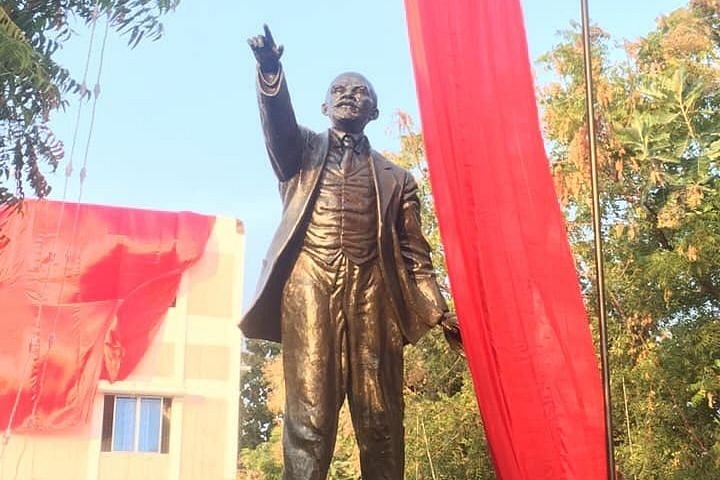Ideas
Lenin Statue In Tripura, Colston In UK, Or Columbus in US – How Woke Left Changes Its Tune
- The world clearly has double-standards on how it deals with its own past on its own shores, and how it allows former colonies and natives to deal with theirs.

A Lenin statue in Tirunelveli. (pic via Twitter)
Remember March 2018? Soon after the Bharatiya Janata Party (BJP) ousted the Communist Party of India (Marxist) from power in Tripura, over-enthusiastic crowds brought down a statue of Vladimir Lenin, leader of the communist party in the Soviet Union.
India’s Left, which continues to idolise mass murderers like Lenin, Stalin and Mao, shed copious tears over the removal of the Lenin statue, and promised a country-wide agitation against it. Card-carrying members of the “secular” club tut-tutted about it (read here, here, here). Many saw it as an attempt to deny history, because statues “create curiosity about a person, about his life and ideas.” Modern historian Ramachandra Guha decried the vandalism in Tripura, even while accepting that Lenin was a “tyrant” and “despot”.
Now, in the wake of widespread protests in America and Europe over racial discrimination following the killing of an Afro-American, George Floyd, by a white police office in Minneapolis, woke anti-racists have been bringing down statues in the US and United Kingdom.
In the US, statues of Christopher Columbus have been beheaded or brought down in many places, and in the UK, a statue of seventeenth century slave trader Edward Colston was pulled down and thrown into a river in Bristol. There is now talk about doing the same to Robert Clive (yes, our very own Clive of India) and Cecil Rhodes, racist and South African mining baron after whom an entire country (Rhodesia, now Zimbabwe) was named.
Now, the western tune on statues has changed. In an interview to The Times of India, British historian Edward Anderson, refused to shed any tears over the tearing down of statues in the UK or US. “Has the toppling of Colston’s statue erased his legacy? Quite the contrary – many more people have been educated about Colston’s atrocities, and Britain’s role in the slave trade than ever before.”
It’s not that Anderson believes that statues of all controversial figures need to be brought down, but even if they remain, their plaques should be more nuanced, containing more elements of the wrongs they did. But, he points out, “statues are erected to memorialise and glorify the subject – they quite literally put people on a pedestal. Statues can even stunt our ability to understand the past: they mythologise, set legacies in stone, and are frequently used to launder reputations worth remembering when institutions that continue to benefit from elite philanthropy resist calls to take down statues of historic donors.”
The Rhodes scholarship, which many Indians have benefited from, effectively makes Cecil Rhodes some kind of liberal philanthropist, when he was nothing of the kind. Alfred Nobel, inventor of dynamite and one-time owner of Bofors, which converted itself from an iron-and-steel maker to an arms manufacturer, now has a peace prize (among other prizes) named after him.
The interviewer, however, seemed to have steered clear of more controversial questions that she could have asked Anderson, including the white-washing of the reputations of bigots like Tipu Sultan or Aurangzeb in India, all of which is being done in the name of writing nuanced history and prevention of Islamophobia. Few would be allowed to write nuanced histories of the Nazi regime, or Pol Pot of Kampuchea, or Slobodan Milosevic of post-Tito Serbia.
While few people in India would bring down statues of Tipu for fear of a communal backlash, surely questions need to be asked about the linkage between laudatory anti-colonial history, where Tipu is shown as a freedom-fighter, and his dubious role in perpetrating crimes against Hindus in Malabar and the Coorg. What is the mental flaw that allowed a sultan to fight the British (while seeking French help) and be hailed as a nationalist freedom fighter but who could, on the other hand, ask his own troops to kill, rape and forcibly convert people from a neighbouring state who merely did not share his religion?
Also, the issue goes beyond just statues. If more nuanced histories need to be written, what is the logic in allowing only Left historians to control those narratives? And how much sense does it make to allow US academicians to control Indology research, where no one who actually represents those voices or traditions is considered fit enough to contribute?
The world clearly has double-standards on how it deals with its own past on its own shores, and how it allows former colonies and natives to deal with theirs. If India brought down a statue of Thomas Babington Macaulay or Robert Clive in India it would cause more disquiet than if the same were done in the UK. This represents skewed power equations, not an attempt to correct past renderings of history.
Introducing ElectionsHQ + 50 Ground Reports Project
The 2024 elections might seem easy to guess, but there are some important questions that shouldn't be missed.
Do freebies still sway voters? Do people prioritise infrastructure when voting? How will Punjab vote?
The answers to these questions provide great insights into where we, as a country, are headed in the years to come.
Swarajya is starting a project with an aim to do 50 solid ground stories and a smart commentary service on WhatsApp, a one-of-a-kind. We'd love your support during this election season.
Click below to contribute.
Latest